Contents
Relative Humidity
Relative humidity (RH) is a measure that expresses the amount of moisture present in a gas (typically air) compared to how much water vapor the air could hold at a specific temperature. This ratio tells you how close you are to total saturation at the dry bulb temperature and given pressure. To put it simply — relative humidity, expressed as a percentage, tells you how full of water vapor the air is relative to its maximum capacity at that temperature. A higher RH means the air is closer to complete saturation, and condensation is more likely to occur.
Understanding the definition of relative humidity is critical to ensuring the reliable and efficient operation of industrial air compressors.
Air compressors take in ambient air, which contains moisture. When air is compressed, the temperature and pressure increase — as does the water vapor density, because warm air can contain more moisture. Once the compressed air cools, the relative humidity increases. If the RH reaches 100%, meaning it’s holding the maximum amount of water vapor it possibly could, it condensates into its liquid form.
Moisture in your air compressor equipment can cause corrosion and wear on internal components. Water can also damage pneumatic tools or cause issues with your compressed air processes. Quincy Compressor designs air dryers and other equipment to combat the impact of humidity on your compressed air systems.
FAQs
Relative humidity and dew point are two concepts that are intertwined in how they relate to the moisture content of the air. Dew point is the temperature at which air is completely saturated and the relative humidity is 100%. The closer the air temperature is to its dew point temperature, the closer it is to saturation.
Relative humidity indicates how close the air is to reaching its dew point. Simply put:
- Higher RH: The dew point is close to the current air temperature, and only a small amount of cooling is needed for condensation to occur.
- Lower RH: The dew point is much lower than the current air temperature, and the air needs to be cooled significantly for condensation to occur.
The higher the relative humidity of the ambient air, the more water vapor enters the air compressor at intake. The compression process only increases the concentration of moisture as the system heats the air being compressed. However, once the compressed air cools, the RH rises — leading to condensation within the compressed air system.
Excess moisture in an industrial air compressor can lead to numerous problems, such as:
- Rust and corrosion in pipelines, valves and other components
- Contamination, such as bacterial growth
- Reduced efficiency of pneumatic tools and equipment
- Quality-control issues, such as diluted paint
- Frozen airlines in colder weather
- Instrument malfunction
- Equipment failure
Moisture control is critical to operations relying on industrial air compressors. Some of the best strategies to control humidity in these environments include:
- Installing air dryers
- Lowering the temperature
- Maintaining proper ventilation
- Installing dehumidifiers
- Using desiccant systems
- Performing regular maintenance to ensure proper functionality
Yes — a dew point sensor can be used to provide an accurate and reliable measurement of moisture content within an air compressor system compared to relative humidity. Many Quincy Compressor air dryer models come with a dew point monitor or offer it as an optional add-on.
Additional Resources
At Quincy, our goal is to support you and true support means connecting you to resources that best fit your needs.


